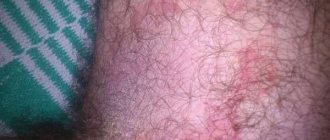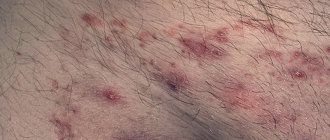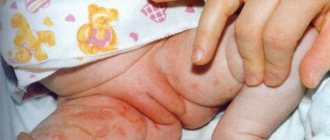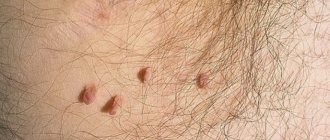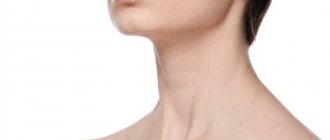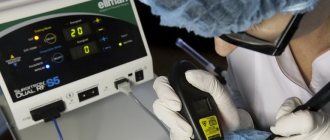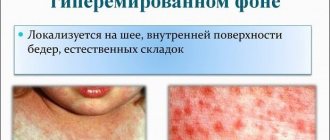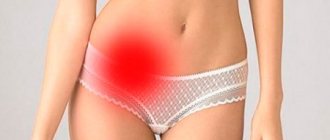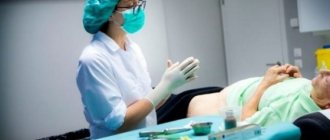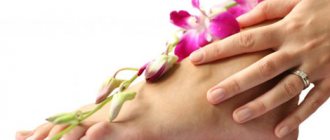Itching is a painful, tickling sensation of inflammation, with a strong desire to scratch the affected area. May sometimes be accompanied by swelling, redness and irritation. On the neck it appears quite often, since the skin here is delicate, sensitive, and also open to external factors.
Severe irritation can cause the skin to become painful and peel, and the rash to spread. Itching may cause you to scratch and scratch the affected area. However, this should not be done, as scratches open the way for infections, and scars can also form in their place.
Most often, itching on the neck is accompanied by a rash, however, there are exceptions. Itching can occur in the front, on the back of the head, or spread to the chest area or to the shoulder blades, depending on the cause.
Causes
There are several reasons why the skin on your neck may itch.
Allergies and skin reactions
Redness and itching rash on the neck due to allergies.
But with mild symptoms, your neck may itch without any visible signs of an allergic reaction. Itchy skin can be caused by irritants, allergens and environmental factors, including:
- Products
- Some types of medicines
- Metals such as cobalt or nickel, which can be found in jewelry
- Plants such as sunflower, primrose, narcissus and chrysanthemum
- Fabrics containing dyes and renin
- Cosmetic ingredients, hair dye, preservatives and others
- Hot and humid weather conditions
- Tanning (ultraviolet irradiation)
Skin NON-infectious diseases and conditions
The main conditions that can lead to itching on the neck:
- Contact dermatitis is an inflammation that occurs upon contact with certain irritants or allergens.
- Eczema is a condition that causes the skin to become dry, red, scaly and itchy.
- Dry skin – can be due to harsh weather conditions such as sun exposure, low humidity levels or even aging.
- Lichen planus is an itchy rash of unknown etiology.
- Psoriasis is a skin disease that causes red, scaly, hard patches of skin covered in gray scales.
- Hives is a condition caused by allergens that results in a raised, red, itchy rash.
- Folliculitis – occurs as a result of inflammation of the hair follicles.
- Prurigo (prurigo) is small blisters accompanied by severe itching.
Some non-infectious causes of itching
Parasites, insects and arachnids
The neck may itch after an arthropod bite, as this area is usually exposed, increasing the risk. Among them:
- Ticks
- Fleas
- Bed bugs
- Mosquito bites
- Scabies mites
- Lice
Infections
An itchy neck can also be a symptom of infections, such as:
- Chickenpox
- Ringworm
- Pityriasis versicolor (lichen versicolor)
- Yeast infection known as candidiasis
- Dermatophytoses – i.e. other fungal infections
Some infectious causes of itching
Other reasons
Sometimes an itchy neck can be caused by stress, smoking, not drinking enough fluids, and extreme cold or heat.
Again, sometimes itching can be a sign of serious or life-threatening conditions that require emergency medical attention. Among these conditions, doctors primarily highlight:
- Allergic reaction
- Chronic kidney failure or chronic kidney disease
- Obstructive biliary disease (this is a blockage of the bile duct)
Spots on the neck itch: disease
In most cases, getting rid of discomfort caused by external factors is not difficult. The problem is much more serious if a person gets sick.
Dermatitis
This is one of the main reasons why red spots appear on the neck and itch. Dermatitis develops against the background of stress, poor nutrition, allergies, burns or frostbite of the skin, and problems with the digestive system.
Allergy
A small pink rash covers large areas of the neck and chest, and watery blisters may subsequently appear. Allergies are provoked by:
- external factors: caring cosmetics, jewelry, clothing, perfume, tap water, animal hair,
- internal factors: drinks, food, medicines, dietary supplements, preservatives.
Infectious diseases
At the initial stage, small spots usually appear, ranging in color from pale pink to red-brown. Visual symptoms of the most common infectious diseases can be compared using photos on the Internet.
- Chicken pox. Small red watery pimples are noticeable all over the body. A person with a weakened immune system may get sick a second time. If an adult has red spots all over the body, including on the neck, which itch and fill with watery fluid, this means that the virus has reached the nerve and skin cells. The duration of this stage is 5-7 days.
- Rubella. Pink, oval-shaped spots appear and the lymph nodes become enlarged. A person who has recovered from the disease develops immunity.
- Measles. Small red spots are localized on the neck, scalp, and behind the ears. At the same time, the voice is hoarse and a “barking” cough is tormenting. The infection is very difficult for children and adults to carry. To reduce the risk of disease, vaccination is done in 2 stages.
- Scarlet fever. A profuse rash appears all over the body and at the same time a severe sore throat, and the temperature rises.
Scleroderma
At the initial stage of the disease, a red spot appears. Over time, the skin becomes rougher and swelling appears. In severe cases, the ability to move the neck is limited.
Lichen
A serious skin disease that affects people of any age. There are several forms of lichen; its causative agents are fungi or viruses. The disease manifests itself as red plaques with a white border or pink spots with a yellowish core. It takes a long time to treat lichen, undergoing complex therapy. Most often, the manifestation is visible throughout the body, including the neck.
Psoriasis
The disease can be hereditary or develop against the background of prolonged stress or allergies. Psoriasis manifests itself as flaky red plaques behind the ears, on the neck, scalp, on the bends of the elbows and knees.
Photodermatosis
During irradiation, at first the red spot on the neck does not itch or flake off, but after 5-7 hours or the next day, swelling and the appearance of a small rash and severe itching are possible.
Associated symptoms
Itching can be accompanied by symptoms of varying severity, depending on the cause.
General symptoms
Below are common symptoms that are likely to accompany itching.
- Rash around the neck
- Swelling, redness and sensitivity of the skin
- Formation of scales
- Soreness
- Crusting or flaking of the skin
Other symptoms
Additionally, symptoms may appear that at first glance are not associated with itching:
- Fever and chills
- Headache
- Runny nose
- Sweating
- A sore throat
- Cough
- Joint pain
Serious symptoms
In certain situations, itching can be accompanied by serious conditions that are life-threatening and require immediate medical attention. Urgent consultation with a doctor is necessary in case of:
- Respiratory complications, such as difficult, rough or wheezing breathing.
- Swelling of the face, tongue, or lips
- Changes in level of consciousness or concentration, such as unresponsiveness or indifference
- Narrowing or obstruction of the throat
- Fever and chills
- Decreased flexibility or joint pain
- Worsening of symptoms despite treatment
During pregnancy and menopause
It should be noted that for many women, itching can often occur anywhere on the body, including the neck, as a result of hormonal changes during pregnancy and menopause.
During pregnancy
Typically, itching in pregnant women is quite common and disappears after childbirth. During pregnancy, numerous skin conditions can occur that can cause itching. These include obstetric cholestasis, an uncommon disorder that affects the liver during pregnancy and causes itching without a rash.
Additionally, some women may develop prurigo, a skin rash that appears as red, itchy dots and usually occurs on the arms but can also affect the neck.
If any rash appears on the body during pregnancy, accompanied by itching, you should visit a doctor as soon as possible to rule out serious pathologies.
During menopause
During menopause, a woman's body undergoes hormonal changes, namely in estrogen levels, which cause itching.
Methods for diagnosing a rash in the neck area
Only a doctor can diagnose a rash of any kind. To do this, he does:
- Visual inspection.
Note: the doctor examines the epidermis not only of the neck area, but also of all other parts of the body.
- Palpation of formations.
- Taking blood and urine to detect infections in the body, as well as assess general health.
- Stomach examination.
- Ultrasound examination of the abdominal cavity.
- Examination of the intestinal tract.
- Allergic reaction test.
Important: such tests are performed if a specialist suspects that the rash occurs due to the use of low-quality products or the consumption of any product.
Which doctor should I contact?
Various doctors are involved in identifying the causes of the appearance of a small red rash, as well as selecting appropriate therapy.
A person who has noticed spots on his skin can contact:
- To a dermatologist. This doctor will rule out or confirm an infectious cause for their manifestations.
- To an allergist, when a person assumes that such a reaction is due to some external irritant.
- A gastroenterologist so that a specialist examines the stomach and intestinal tract.
- A cosmetologist if a person is sure that the rash is caused by low-quality cosmetics.
- An endocrinologist if there is a suspicion that the rash occurs against the background of hormonal changes in the body.
Advice: women are required to undergo examination by gynecologists in parallel with endocrinologists.
In an adult, a small red rash on the neck can appear for numerous reasons, and can also vary in size or shape. Only doctors and after a comprehensive examination of the patient’s body can identify the true factors that lead to such processes.
Blitz tips:
- You cannot self-medicate, such actions will only aggravate the existing pathology;
- if the doctor has prescribed therapy, then it is important to follow all his recommendations in order to achieve complete cleansing of the skin;
- never try to squeeze out an abscess, pustules, etc. that have appeared, since a scar will remain on the skin, and most importantly, it is possible that the infection will spread throughout the body.
Treatment
If the itching is not severe, you can use the home remedies and treatments given below:
Cold water bath
The simplest home remedy is to take a bath in cool or not too warm salted water. These simple ways can help relieve itching.
Ointments and antihistamines
Another helpful remedy is the use of topical ointments such as hydrocortisone to reduce inflammation.
If the itching is caused by an allergic reaction, the best solution is to take antihistamines.
Baking powder for the dough
You can also make a mask of baking powder to relieve itching. To prepare the paste, take two vitamin C tablets (ascorbic acid), a few drops of water and a little baking powder. Mix all the ingredients until a thick paste is obtained and apply to the affected area.
Oatmeal bath
To relieve itching, you can take an oatmeal bath. To do this, take a cup (1/3 for a child) of oatmeal, cereal, or even just unprocessed grain (anything will work fine). Grind as finely as possible using a coffee grinder or food processor so that the powder can dissolve completely in the water and turn it white. If it doesn’t work out so finely, you can sift it. Take a bath for at least 15 minutes, after mixing the resulting powder in it.
Additional funds
Try rubbing olive oil on your skin and using moisturizers to help soothe the itching a little. Aloe Vera is another great product that will effectively relieve symptoms.
Wash clothes, bedding and towels using products that do not contain fragrances or fragrances. Use an extra rinse to remove as many chemicals as possible from your laundry.
It is also better to wear clothes made from natural fibers, such as cotton, which are soft enough and will not irritate the skin like wool or polyester. Try to choose clothes that fit loosely around your neck so that the fabric does not irritate your skin.
Last tip
Do not scratch or itch the skin on the affected areas, as even minor injuries open the door to infection. In older people, even a small scratch can cause bleeding. It is worth considering that constant rashes on the body and itching can signal the presence of serious diseases such as diabetes or kidney disease.
If you have severe symptoms, or if the rash from your neck spreads throughout your body, you should see a doctor immediately.
( 1 ratings, average: 5.00 out of 5)
Diagnosis of red spots on the neck
When red spots on the neck itch, only a doctor can determine what it could be. First of all, you should contact a dermatologist. After the initial examination, you may need to consult an immunologist or infectious disease specialist.
First, the doctor conducts an examination and collects anamnesis, then prescribes a laboratory and instrumental examination:
- general and bacteriological blood tests,
- general urine analysis,
- scraping from the affected area,
- Ultrasound of the abdominal cavity,
- tests to identify allergens.
If necessary, a consultation is held and additional studies are conducted to make an accurate diagnosis.
